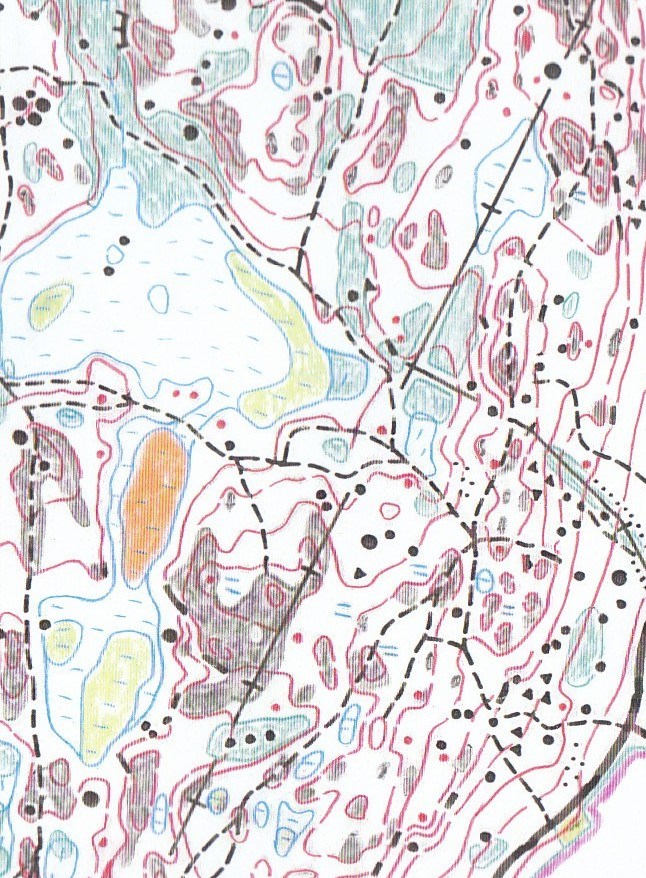Notwithstanding all associated program and services, the most essential thing in Jukola relay is the map. It’s an undisputed requisite for any action to be called orienteering. At Louna-Jukola, this issue could not be in better hands, as the person responsible for the competition map is well-known for most active orienteers: Jussi Silvennoinen. But what kind of a man is Jussi as a mapper?
Silvennoinen, having drawn his first features on the map in the end of 1970’s, has long been one the most recognized mappers in Finland. His resume comprises over a hundred maps, including many Finnish championship maps and a part of the maps at World Orienteering Championships 2013 in Vuokatti. With this experience in mind, it might seem a bit surprising that, for the time being, Silvennoinen has been responsible for the map of Jukola only once (2006 in Salo).
The making of the map of Louna-Jukola began in winter 2013 by preparing the ground material. Spring and summer in the same year were largely spent in Paimio doing fieldwork. After finishing the actual competition map, Silvennoinen has made training maps for Louna-Jukola.
– Even though mapping projects are pretty much like each other, the word ”Jukola” brings quite a lot of shine to the work. For example, when eating my packed lunch in the forest, I often thought about the line of lights that might be running past at that point in the night of the upcoming Jukola, Silvennoinen recalls.
The ground data needed for making an orienteering map have continuously become better, and nowadays the open datasets of the National Land Survey of Finland include just about everything needed. Especially contours created through laser scanning data provide an incomparable accuracy. On the other hand, a large amount of information often has a reverse side.
– The data I used in this project included the National Land Survey’s laser scanning data, the Topographic database, cadastral boundaries and aerial photos – and that was abundantly enough. Surely, I could have addedly used vegetation patterns extracted from laser scanning data, for example. However, less is usually adequate – I don’t want the final product to be full of redundant details, Silvennoinen reflects.
These days, many professional mappers work in the forest using a tablet computer and GPS. Silvennoinen, however, is an “old school” man: using ordinary pens he draws on a plastic film covering printed ground material, then the film is scanned and used as background image in a specialized computer software.
Silvennoinen explains he feels joy of creativity and rewarding sensations when he’s able to generate the map basically “by himself”, without extra help from technology. For the second, a tablet computer is for no help with the challenges induced by weather and terrain conditions. The major reason is however a practical one.
– This way, my productivity is higher: drafting the map manually is considerably faster than drawing a finished map on a tablet. In the following winter, I’ll definitely have enough time to sit by the computer and draw, explains Silvennoinen.
Although, he admits that good enough ground material is a prerequisite for using the “traditional” mapping method effectively. Thus, using more technology is not ruled out for good.
– Had I not had laser-based contours in Paimio, I probably would’ve acquired a tablet computer already.
Spending hour after hour in the forest, a mapper sees and experiences all kinds of things, from animals to unusual weather phenomena. Does Jussi remember something distinctive from the forests of Louna-Jukola? Yes – a bottle.
Silvennoinen had been looking at the map of the 1972 Jukola relay – held in the same area – and while mapping he examined the control points of that competition more closely. Expectedly, no control equipment from that long ago existed anymore. Nevertheless, one day he came to the first control of the first leg.
– That was on the foot of a high cliff, somewhat hidden from ordinary passers-by. And a brown glass bottle peeked out of the ground, the kind they sold lemonade in when I was a child. I dare to guess it was the drinking bottle of the person manning the control in 1972 Jukola. Well, I didn’t taste the contents but just left it on its place partly covered with moss. Indeed, it brought me back memories, says Silvennoinen.
You have the opportunity to enjoy the result of Silvennoinen’s work by participating in Louna-Jukola. Don’t forget the first registration threshold on Wednesday, February 4th!

The terrain draft drawn by Jussi Silvennoinen would almost suffice for a final competition map as such.





























